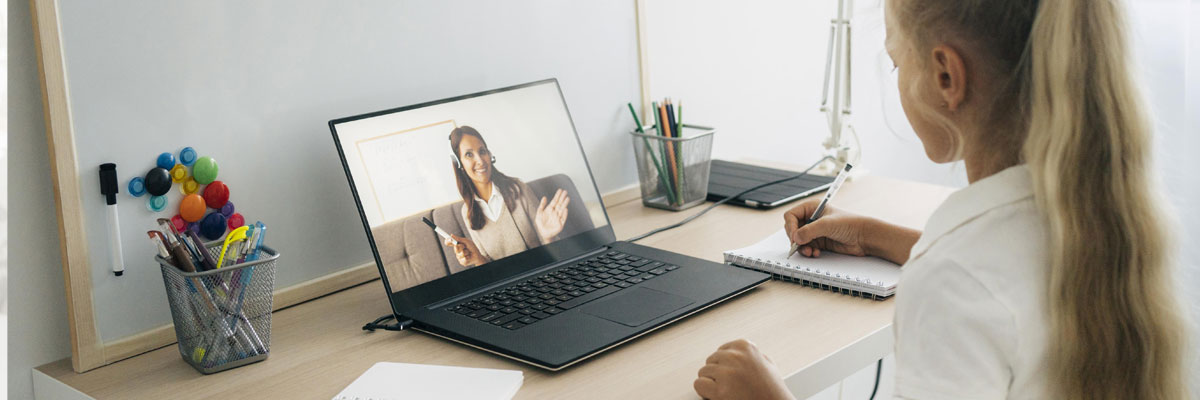Ensuring online safety in remote teaching and learning
Posted on 9 February 2021 by Melanie Thomson

Ask any head teacher what aspects of their job keep them awake at night and most will cite safeguarding as one of them. The expectations for schools to Keep Children Safe in Education has evolved and expanded over time and the past year has been no different.
Whilst schools in England have remained open during lockdowns to children considered vulnerable (as well as children of critical workers), not all are attending school in-person. In addition, children are spending an increasing amount of time online – both for remote learning and for entertainment, in the absence of many of their usual extra-curricular activities.
The current situation is increasing the risk of online harm for many children and makes this year’s Safer Internet Day more important than ever, as a reminder that schools, parents, carers and online technology providers must work together for a better internet.
Schools and teachers can exemplify best practice in staying safe online during this time of remote education in a number of ways:
-
Adopt a consistent ‘whole school’ approach
The remote teaching and learning policies that schools and multi academy trusts have created should provide clarity and guidance on the school’s approach to remote education. Which online platforms should you utilise and how much flexibility do you have over how you deliver your curriculum offer? What are the expectations for the amount and frequency of work to be set, feedback provided to pupils and communication with parents and carers?
-
Set the ground rules for online learning
Most platforms that are being set up for schools to use for remote teaching of live lessons provide the ability for the meeting organiser (teacher) to maintain technical or host control of their meetings (live lessons). Ensure settings are applied to ensure pupils can’t mute each other, remove the teacher from the meeting or admit unknown guests into the meeting. Does the teacher have visibility of any conversations happening in the chat function?
Advise pupils and their parents or carers on etiquette and expectations for live lessons: should a responsible adult be nearby to support the child where needed? Should video be turned on or off? Are the teacher or children able to blur their background if additional privacy is needed? Should the teacher record the meeting?
-
Be (cyber)-security conscious
Setting weak passwords can be one of the biggest vulnerabilities to potential cyber-attacks, malicious access to systems and data breaches. Follow the National Cyber Security Centre’s advice to improve your online security through robust password setting and password management as well as implementing multi factor authentication (MFA) where possible. Don’t forget to also set secure passwords on any mobile devices, including phones, that you may use to access school systems such as email.
Phishing attacks and ransomware are also used to get access to data. Your email and online firewall should be set up to intercept as many suspicious and potentially dangerous emails as possible, but it is important to remain alert and ensure you can spot the signs of a potential phishing attempt as they become increasingly sophisticated and know what action to take if you receive one.
Make sure you know where your data and content is stored. Does your school have a common approach and robust systems for handling sensitive data? Do you know what data you have stored on your devices? Files are often automatically downloaded when shared as email attachments and can sit in a downloads folder on your device without you realising.
-
Find a balance in how you use technology
In line with your school’s approach, do you have the flexibility to find a balance of live and asynchronous teaching? Online and offline activity? This will no doubt differ between age groups and schools but initial EEF research suggests that remote education does not need to be delivered solely through live lessons.
-
Embed digital literacy
Arguably, the most crucial aspect of keeping children safe online is to educate them to be digitally literate. Beyond the fact that many school age children will be incredibly adept at using technology, their ability to use it wisely and keep themselves safe online is still very much in development.
The Personal, Social, Health and Economic education (PHSE) curriculum incorporates digital literacy throughout the key stages. Educating children in an age-appropriate way about what type of personal information to avoid sharing online, how to ensure their privacy and security settings on social media platforms are sufficient and understanding that not everyone and everything online is reliable and trustworthy, are vital in helping young people navigate the digital landscape safely.
-
Engage parents and carers
When devices are used by children at school they should have online filtering and monitoring controls to help shield them from inappropriate content and flag up potential concerns over browser and search history. Similar software can be installed on school devices that are used by children at home. It is common, of course, for children to use family or personal devices in the home for remote learning as well as for entertainment. Providing advice or links to training resources can be invaluable in empowering parents and carers to navigate parental controls and have conversations with their children about their experiences of the online world.
The responsibility for keeping children safe online cannot fall solely to schools of course. As in the African proverb “it takes a village to raise a child”, Safer Internet Day 2021 reminds us that “whether you are a young person, a parent or carer, a teacher or an educator, a policy maker, or whether you represent an organisation or industry, everyone has a role to play in creating and maintaining a better online world”.
Melanie Thomson is Head of Acquisition Marketing at RM and the Safeguarding Link Governor at a primary school in West Oxfordshire.
Further advice on staying safe on your remote education platform: